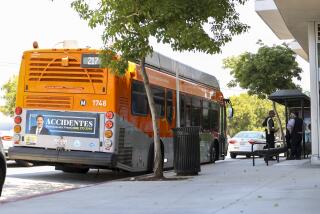20 Cities Back Bus Zone to Replace RTD
- Share via
La Habra Heights has given final approval to joining the newly formed Foothill Transit Zone, which will contract with private bus companies for new service in the San Gabriel Valley and part of Southeast Los Angeles County.
But La Habra Heights--a tiny, rambling bedroom community--has no bus service and doesn’t anticipate getting any in the foreseeable future. Still, Councilman M. Jay Collins says city leaders support the spirit of the new transit zone.
“They’re committed to being lean and mean in terms of their approach to productivity, and we’re committed to that too,” said Collins, who is nonetheless concerned the city may have to contribute to the new transit district. For that reason, he opposed the transit proposal, which passed 3-1, with Councilman Charles Wolfarth abstaining.
Twenty cities have now agreed to participate in the new service, a local alternative to the Southern California Rapid Transit District. Service will begin phasing in during July, and will take over all of the RTD’s service in those cities by 1990. Beyond that, the plan is indefinite, so it is uncertain when--or if--La Habra Heights would benefit from the transit district.
In addition to La Habra Heights, the zone has now been endorsed by the county, the City of Industry, Arcadia, Azusa, Baldwin Park, Bradbury, Claremont, Covina, Duarte, El Monte, Glendora, Irwindale, La Verne, Monrovia, Pomona, San Dimas, South El Monte, Temple City, Walnut and West Covina.
Creation of the transit zone has been a four-year crusade for Supervisor Pete Schabarum, who says it will provide better, more cost-effective service than the RTD. In December, the Los Angeles County Transportation Commission, which had denied a previous application, approved a three-year trial run for the transit zone.
The commission has jurisdiction over transportation systems in the county, distributing state and federal transportation funds. If the zone can show a 25% savings while providing comparable service to the RTD, the commission may opt to make it a permanent entity.
Schabarum has estimated that the zone will save up to $9 million a year, which he said will be used to keep fares low and expand service.
“The beauty of this project is that those savings will stay in the transportation zone to expand service and lower fares . . . eliminating the RTD’s downward spiral of raising fares and cutting suburban service,” he said in a statement released this week.
When fully operating in 1990, the zone is expected to have a ridership of 9.5 million and 127 buses in operation during peak hours, according to William P. Forsythe, the county consultant for the project.
Under its governing agreement, the zone will be divided equally into four clusters of five neighboring cities. Population in each cluster is about 200,000. Each city will appoint a representative to the transit zone.
The first transit zone meeting is tentatively slated for May 4, when zone members--elected officials from each of the cities and two county appointees--will adopt rules governing the agency.
As part of the first meeting, zone members are being asked to approve a governing board that would oversee contracts and minor route changes. This five-member executive board would have one member from each of the four city clusters and a county representative. All budgetary matters and major service changes would be voted on by all 22 zone members.
The regulations, which the cities had a hand in drafting, will probably be approved with only minor revisions, Forsythe said.
“It should only be minor clarification issues,” he said. “It’s not really any major changes that I’ve heard of from the cities.”
The transit zone is a scaled-back version of a plan Schabarum first proposed in 1984 for 29 cities in the San Gabriel Valley. Pasadena, La Puente and San Gabriel chose not to take part, while six others--Alhambra, Monterey Park, Rosemead, Sierra Madre, San Marino and South Pasadena--were cut from the project to win county Transportation Commission approval.
In July, the transit zone will take over two RTD lines, providing express service from Diamond Bar and Rowland Heights to downtown Los Angeles. Four more routes will be added in December, with a total of 14 lines being phased in over the next two years.
Times staff writer Bettina Boxall contributed to this story.
More to Read
Sign up for Essential California
The most important California stories and recommendations in your inbox every morning.
You may occasionally receive promotional content from the Los Angeles Times.













